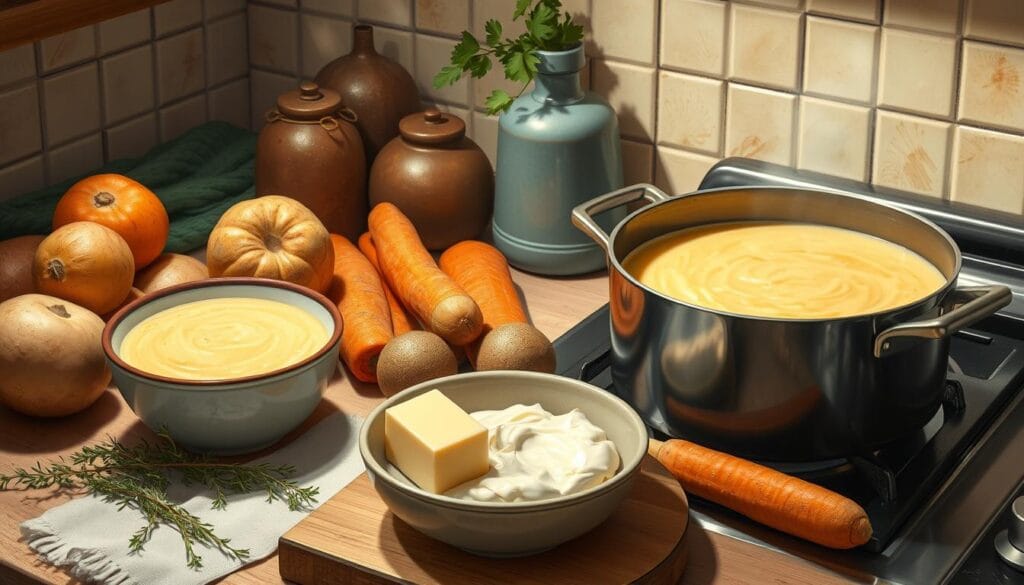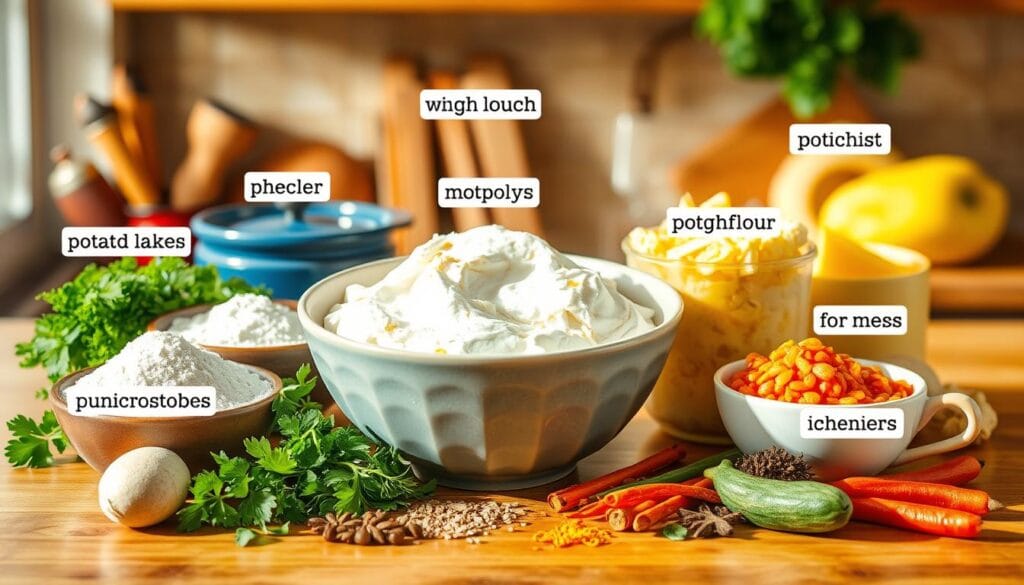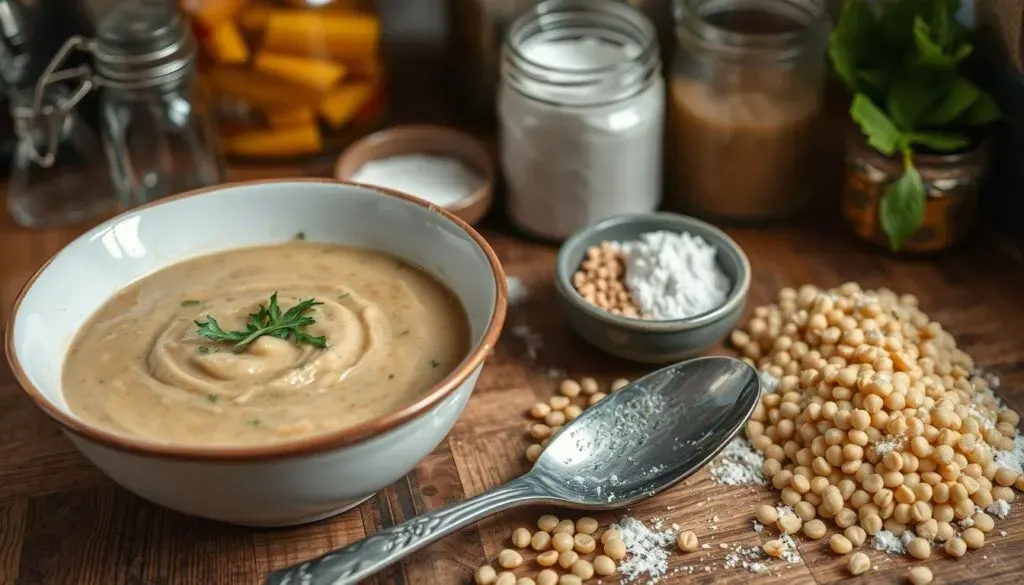Turning a simple broth into a rich, velvety meal is an art you can learn. Making soup thick and creamy boosts flavors and makes a dish perfect for any time. With a few simple steps, you can turn thin, watery soups into thick, creamy ones that taste amazing.
This guide will show you different ways to make creamy soups. It also talks about the importance of soup consistency. This ensures your soups look good and taste great.
Table of contents
- Understanding Soup Consistency
- What Makes Soup Thick and Creamy?
- How to Make Soup Thick and Creamy
- Common Thickening Agents
- The Secret Ingredients for Richness
- How to Thicken Soup with Potatoes
- How to Thicken Soup with Milk
- Using Bread as a Thickening Agent
- How to Thicken Soup without Flour
- Restaurant Techniques for Thickening Soup
- Step-by-Step Guide to Making Delicious Soup
- FAQ
- Conclusion
Understanding Soup Consistency
Soup consistency is key to a dish’s appeal and satisfaction. Getting the right mix of liquid and solid ingredients makes a soup perfect. Factors like simmering time, temperature, and ingredient choice play a role.
Using potatoes, beans, or lentils can make a soup thicker. Different broths need different approaches for the right creamy texture. For example, light broths might need less thickening, while hearty stews need more.
The way you prepare your soup affects its flavors and textures. Adding cream can make your soup richer. This is a flavorful recommendation to consider.
For a creamy texture, try using a stick blender after cooking. It blends ingredients well, making your soup smooth. Toppings like Parmesan cheese can also add richness and enhance flavors. A well-made soup is not just tasty but also healthy.

What Makes Soup Thick and Creamy?
A thick and creamy soup makes any meal better. It adds richness and satisfaction. Knowing what makes soup creamy is key to getting that perfect texture. There are many creamy soup ingredients to choose from, fitting different diets.
Starchy foods like potatoes, sweet potatoes, or cooked rice can thicken soups. They also add great flavors. Red lentils are another good choice, making soups smooth and rich.
Dairy like heavy cream, plain yogurt, and sour cream add creaminess. For those who don’t eat dairy, coconut milk and coconut cream are great alternatives. They make soups creamy without dairy.
Using stale bread or breadcrumbs can also improve texture. They dissolve in vegetable soups, making them velvety. For gluten-free options, arrowroot powder, tapioca starch, or potato starch work well. They thicken soups without adding calories.
Egg yolks can make soups smooth and luxurious. You can also try white beans, oats, ground nuts, and Yukon Gold potatoes. They add unique flavors and textures to soups.

| Ingredient | Type | Texture Enhancement |
|---|---|---|
| Potatoes | Starchy Food | Thickens and adds creaminess |
| Red Lentils | Legume | Creates smooth texture |
| Heavy Cream | Dairy | Richness and thickness |
| Coconut Milk | Dairy Alternative | Creamy consistency |
| Stale Bread | Thickening Agent | Velvety finish |
| Arrowroot Powder | Thickener | Gluten-free thickening |
| Egg Yolks | Thickening Agent | Luxurious smoothness |
How to Make Soup Thick and Creamy
Making a deliciously thick and creamy soup starts with the right ingredients and base. Knowing how to make your soup thick and creamy leads to a comforting bowl. The right thickening agents can make your soup even more satisfying.
Importance of Ingredients
Every ingredient is key to achieving the perfect creaminess. Here are some top choices for thickening:
- Starchy foods: Potatoes, rice, and legumes are excellent choices.
- Dairy products: Heavy cream or yogurt can create a rich texture.
- Vegetables: Incorporate options like carrots and celery to add body.
The thickening agent importance cannot be understated, as it determines the overall mouthfeel of your soup.
Choosing the Right Base
Choosing the right soup base is critical for a thick and creamy soup. Different bases offer different richness and flavors. For example, chicken or vegetable broth is a solid foundation. Consider:
- Low-sodium chicken broth for a balanced flavor.
- Vegetable broth for a lighter, plant-based option.
- White wine or additional broth can enhance flavor if used wisely.
Combine these bases with your chosen thickening agents for the ultimate creamy outcome.
By focusing on these key aspects, you can master making soup thick and creamy. Each bite will feel indulgent and hearty.
Common Thickening Agents
Getting the right thickness and creaminess in your soup is key. Knowing your options can make a big difference. Here are some top picks to boost your soup’s consistency.
Flour and Cornflour
Flour is a go-to thickener in many dishes. Making a roux with flour and fat adds flavor as it cooks. It changes from pale to dark brown, enriching soups and sauces.
Cornflour, known for its smoothness, is a top starch choice. To thicken well, mix it into a runny slurry and add it back to your pot. This method ensures even thickening, making it a reliable option.
Blending Techniques
Blending can also make your soup creamier. Pureeing some of the soup balances chunky and smooth textures. It enhances the mouthfeel and blends flavors well.
Try different blending methods to find your perfect consistency. It’s a great way to customize your soup’s texture.

The Secret Ingredients for Richness
To make your soup richer, try adding special ingredients. These can change the flavor and texture. Adding cream or yogurt at the end can make your soup feel luxurious.
This method not only adds richness but also a tangy taste. It’s a simple way to improve your soup.
Add Cream or Yogurt
Adding cream makes your soup velvety. Heavy cream turns simple soups into comforting meals. It adds a luxurious feel.
Yogurt, on the other hand, adds a tangy taste. It’s great in soups with strong flavors. It balances the taste with its acidity.
Alternative Creams for Thickening
If you’re looking for dairy-free options, try coconut milk or nut-based creams. They’re great for thickening and are good for different diets. You can use almond milk, cashew cream, or coconut milk.
| Ingredient Type | Texture Added | Flavor Profile |
|---|---|---|
| Heavy Cream | Velvety | Rich and Decadent |
| Yogurt | Silky | Tangy and Bright |
| Coconut Milk | Creamy | Sweet and Tropical |
| Almond Milk | Light | Nuts and Subtle Sweetness |
| Cashew Cream | Rich | Earthy and Smooth |
How to Thicken Soup with Potatoes
Using potatoes in soup is a great way to make it thicker and creamier. Potatoes naturally thicken the soup and add flavor. By following the right steps, your soup will become a hearty meal.
Incorporating Potatoes into Your Recipe
Begin by peeling and dicing 3 1/2 pounds of Yukon Gold potatoes. This type of potato adds a buttery texture that blends well with other ingredients. Add the diced potatoes to your soup and simmer until they’re tender, about 10-15 minutes.
This step is key because tender potatoes blend well into the broth. It makes the soup luscious and creamy.
Blending for Creaminess
Mash half of the cooked potatoes and leave the rest chunky. This mix of textures adds richness to your soup. You can blend the mashed potatoes into the soup for extra creaminess.
Adding sour cream or shredded cheddar cheese can also enrich the flavor. For a vegan option, use vegetable oil or plant butter.
Consider adding celery, stock, bacon, or sharp cheddar cheese to customize the taste. Using potatoes in soup is easy and makes a delicious, hearty dish.
How to Thicken Soup with Milk
Using milk is a great way to make your soup creamy and flavorful. Start by picking the right milk type—whole or low-fat. Add milk towards the end of cooking to avoid curdling. This keeps your soup smooth.
Here are some thicken soup techniques to try with milk:
- Gradually stir in the milk for even distribution.
- Keep the heat low to prevent boiling.
- Add spices and herbs for extra flavor.
Making a creamy soup with milk can take your cooking to the next level. Blend fiber-rich veggies like sweet potatoes or butternut squash into your soup. This adds both richness and nutrition, making your dish more satisfying.
Using Bread as a Thickening Agent
Bread is great for thickening soups, even the stale ones. It absorbs liquids, making your broth creamy. Just tear the bread into your pot, let it soak, and then blend it for extra flavor.
Using tortillas in soup is another cool trick. Blend them into a paste to thicken and add flavor. It’s a fun way to mix up your soup recipes.
Here’s a quick comparison of common bread options for thickening soup:
| Type of Bread | Flavor Profile | Best Used In |
|---|---|---|
| Sourdough | Tangy and robust | Chowders and stews |
| White Bread | Mild and subtle | Vegetable soups |
| Whole Grain | Nutty and earthy | Hearty soups |
| Tortillas | Soft and versatile | Mexican-style soups |
Using bread to thicken soups adds depth and richness. It’s a great way to improve both texture and taste in your soups.
How to Thicken Soup without Flour
Looking for ways to thicken soup without flour opens up a world of options. You can make delicious, hearty bowls without wheat. This is great for those with dietary restrictions or who prefer healthier choices. Many alternatives can make your soup thicker and more nutritious.
Alternatives for Gluten-Free Options
Using cornstarch, arrowroot powder, or tapioca starch can help thicken your soup without gluten. For a healthier option, try:
- Mashed potatoes or other starchy vegetables like sweet potatoes
- Puréed vegetables, which can provide a rich mouthfeel
- Legumes like white beans that not only thicken but also add protein
- Ground nuts for a nutty flavor and creamy texture
- Egg yolks for a luxurious finish in creamy soups
For a healthier thickening method, blend part of the soup. This makes it velvety while keeping the dish’s flavor. You can adjust the thickness and richness to your liking, making each soup unique.
Restaurant Techniques for Thickening Soup
In the culinary world, restaurants use many ways to make soups just right. They focus on professional thickening methods to improve soup quality. One key method is using sourdough discard, which makes soups creamy like ranch dressing.
To use sourdough discard, take a cup of hot soup from the pot. Mix in some discard and then add it back. This makes the soup richer and thicker. It also adds a special flavor that goes well with soups.
Another cool trick is to use leftover French fries to thicken soup. This hack is loved by those who enjoy takeout. French fries add starch and flavor, making soups creamy. Just remember to reduce salt if using store-bought fries.
Other ways to thicken soup include blending cooked beans or lentils, or using winter veggies like squash. Adding sour cream or yogurt can also make soups creamy. These methods can make your homemade soups taste like they’re from a fancy restaurant.
Step-by-Step Guide to Making Delicious Soup
A well-crafted soup can make any meal better. It’s key to follow a soup making guide. This step-by-step soup preparation will boost your kitchen skills. You’ll learn to make delicious soup easily.
Start by picking your ingredients. Choose fresh items like onions, garlic, Yukon Gold potatoes, and carrots. For protein, add rotisserie chicken or fresh herbs. Prepping these ingredients makes cooking smoother.
Then, pick a liquid base. Options include chicken or vegetable broth, coconut milk, or dairy like whole milk and heavy cream. Use flour or cornstarch for thickening to get that creamy texture.
- Cooking Time: Aim for a total of about 46 minutes for your soup.
- Servings: This recipe is suitable for 3 to 4 servings.
- Recipe Rating: Enjoy a 4.95 out of 5 rating based on 516 votes.
Focus on precise cooking methods to enhance flavor. Start by sautéing your aromatics until fragrant. Then, add root vegetables and enough liquid. Let your soup simmer to blend all flavors. Watch cooking times to avoid overcooking.
Lastly, add dairy slowly to avoid curdling. Use the right methods for reheating and storing your soup. By following these steps, you’ll not only cook delicious soup but also improve your cooking skills for other recipes.
FAQ
Soup gets thick and creamy from starchy ingredients like potatoes or beans. Blending and adding dairy products like cream or yogurt also help.
Secret ingredients include starchy veggies like potatoes and pureed legumes. Adding cream thickens and enriches the flavor.
Heavy cream is top for thickening soup. Half-and-half or coconut cream are good alternatives for a similar texture.
Restaurants use beurre manié (flour and butter mix), emulsions, and starchy thickeners like flour and cornstarch. These methods create a smooth, rich soup.
Thicken soup without flour by using cornstarch, mashed potatoes, or pureed veggies. Lentils and beans also add a hearty texture.
Mix flour with cold water to make a slurry. Stir this into hot soup and simmer to thicken.
Add diced or sliced potatoes to the soup and cook until tender. Blend some soup for extra creaminess.
Add milk towards the end of cooking. Do it slowly to avoid curdling. Whole milk adds richness, while low-fat milk is lighter.
Conclusion
Making a thick and creamy soup is more than just a recipe. It’s about knowing your ingredients and techniques. By picking the right base and adding thickeners like potatoes or milk, you can make a delicious soup in under an hour. These soups are great for families or gatherings, perfect for busy days.
Remember, experimenting with different thickeners and flavors is key. Try new things in your kitchen. You can adjust the soup’s texture with stock or milk to make it just right for you. This way, your soup will be a true reflection of your taste.
Learning these skills and trying new ingredients will make cooking fun. Whether you use a homemade mix or fresh garden ingredients, you can create something amazing. Start your soup-making adventure and enjoy every step!

